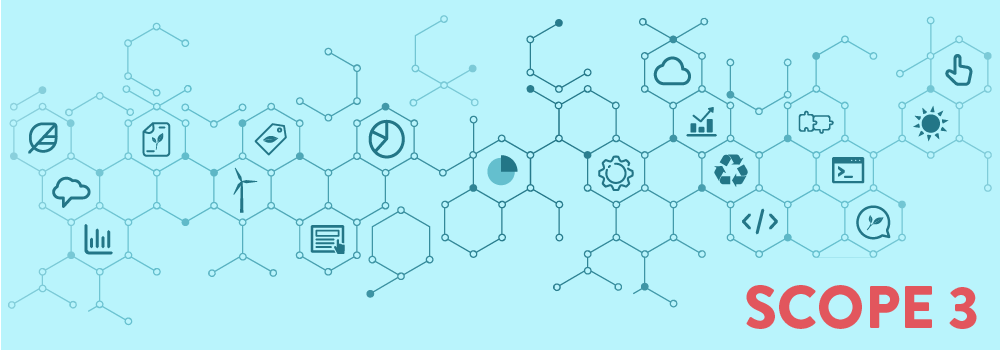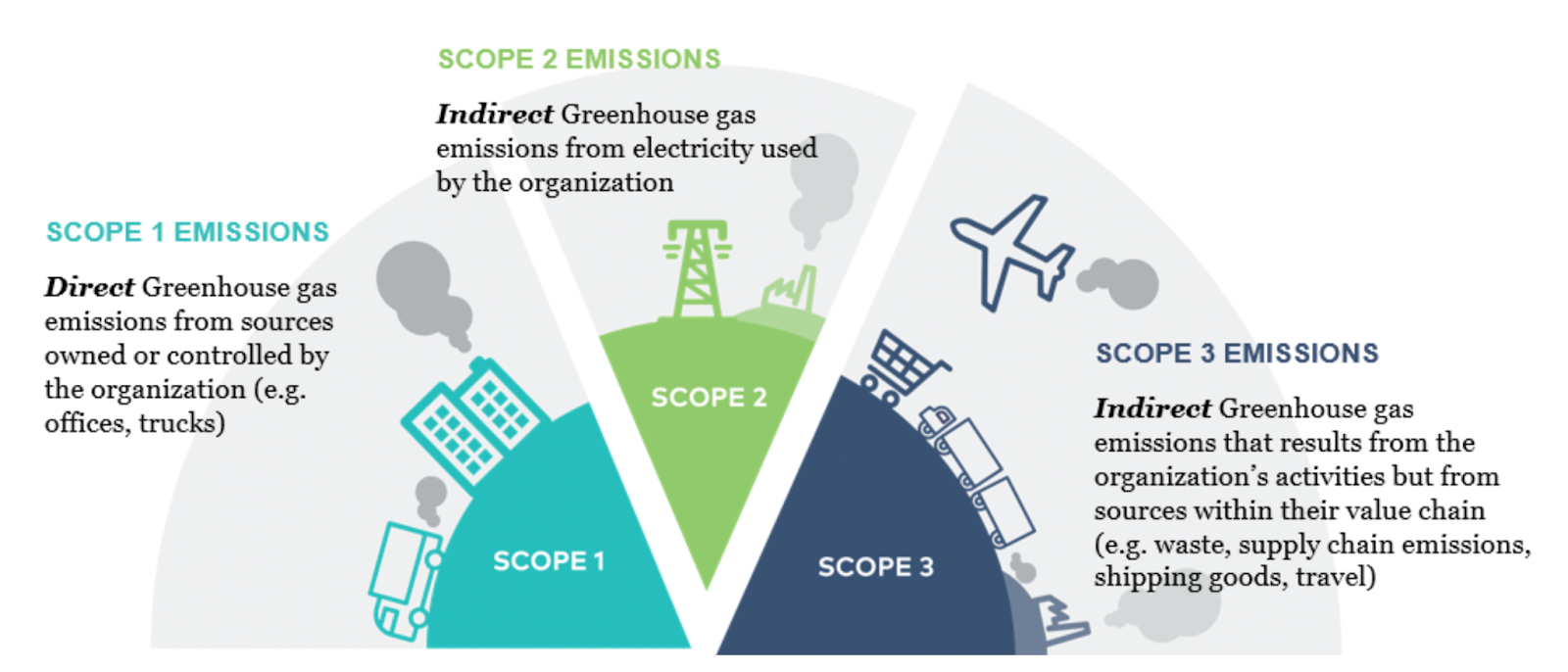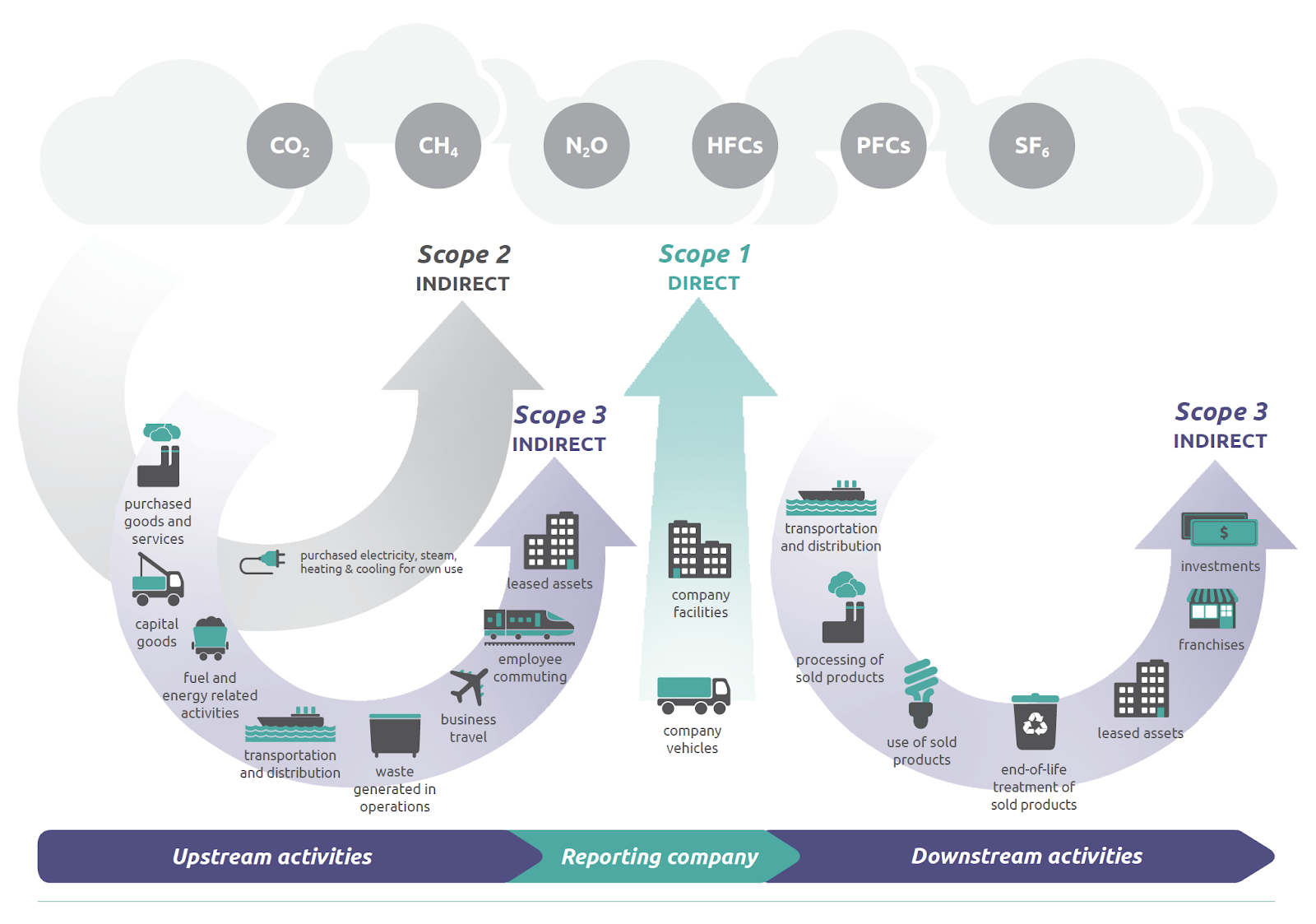Scope 3 Emissions in Your Digital Supply Chain

In this post, we cover the role Scope 3 emissions in your digital supply chain play in creating meaningful climate impact. We also share five ways to address them.
Prioritizing Scope 3 emissions—those that come from supply chains and use of third party products and services—is challenging for most organizations. These emissions are typically out of an organization’s direct control, making them the hardest to track and reduce.
However, Scope 3 emissions also make up the majority of an organization’s total emissions footprint—more than 90% by some estimates. Also, recent developments indicate that taking action on Scope 3 emissions could transition from optional to mandatory for many businesses in the near future. Is your organization ready?
To better understand the challenge ahead, let’s explore why tracking and reducing Scope 3 emissions is so complicated, yet also so important. For the purpose of this post, we’ll focus on Scope 3 emissions in marketing and ad tech. However, the situation is similar across industries.

Your Digital Supply Chain
An organization’s supply chain includes the vendors, partners, and suppliers within its business ecosystem. These partners are critical to the organization’s ability to successfully conduct business.
Similarly, digital is ubiquitous in most organizations. Your digital supply chain consists of the third-party digital products and services you use to run and manage campaigns, profiles, online programs, and so on. Marketing technology alone includes more than 10,000 tools and platforms (see pic above), most of which are offered as software-as-a-service (SaaS) solutions.
However, lists like the one above don’t typically include a company’s environmental claims or commitments to renewable energy. Also, many of these companies don’t feature public-facing climate strategies or environmental claims on their websites either.
Organizations looking to partner with values-aligned vendors to reduce Scope 3 emissions in their digital supply chains will need to dig deeper. Purpose-driven marketers and business leaders have their work cut out for them in this regard.

Understanding Emissions Scopes
Every five weeks brings us one percent closer to the Paris Agreement’s 2030 target of reducing global emissions by 45 percent, so the time for decisive action really is upon us.
— James Butcher, Most Businesses Don’t Understand Scope 3 Emissions — Here’s Why
The Greenhouse Gas (GHG) Protocol is the world’s most widely used greenhouse gas accounting standard. It breaks emissions into three types or ‘scopes’:
- Scope 1: direct emissions associated with emissions sources that are owned or otherwise controlled by an organization
- Scope 2: indirect emissions associated with electricity used by an organization
- Scope 3: upstream and downstream emissions associated with an organization’s value chain
Under the GHG protocol, organizations must identify the boundaries of their emissions impact and come up with a reduction and mitigation plan.
For digital emissions, Scopes 1 and 2 are relatively straightforward. To learn more about how these impact digital businesses, check out our post What is ‘Net Zero’ for a Digital Business?
Scope 3 is more complicated. It is also most relevant to addressing your digital carbon footprint. Here’s how.
Scope 3 Emissions
The Scope 3 Standard is the only internationally accepted method for companies to account for these types of value chain emissions. It represents emissions from 15 categories of Scope 3 activities, both upstream and downstream of their operations. The Scope 3 framework also supports strategies to partner with suppliers and customers to address climate impacts throughout the value chain.
— Greenhouse Gas Protocol, Corporate Value Chain (Scope 3) Accounting and Reporting Standard
In addition to organizational and product boundaries, Scope 3 emissions are also broken down into two focus areas—upstream and downstream activities. There are a total of fifteen categories that fall under a comprehensive Scope 3 emissions inventory.
Upstream vs. Downstream Emissions
Scope 3 includes activities related to purchased goods and services, including their use and disposal. Herein lies our best chance to understand and reduce emissions associated with digital products and services.
Upstream Activities
Upstream emissions occur during the creation, production, and manufacturing of products or services that an organization purchases.
- Purchased goods and services: extraction, production, and transportation of goods and services purchased or acquired by the company
- Capital goods: extraction, production, and transportation of capital goods purchased or acquired by the company
- Fuel and energy-related activities: extraction, production, and transportation of fuels and energy purchased or acquired by the company which are not already accounted for in scope 1 or scope 2
- Upstream transportation and distribution: transportation and distribution of products purchased by the company, as well as other transportation and distribution services like inbound logistics, outbound logistics, and transpiration between company facilities
- Waste generated in operations: disposal and treatment of waste generated in the company’s operations, in facilities not owned or controlled by the company
- Business travel: transportation of employees for business-related activities in vehicles not owned or operated by the company
- Employee commuting: transportation of employees between their homes and their worksites in vehicles not owned or operated by the company
- Leased assets: operation of assets leased by the company and not included in Scope 1 and Scope 2
Downstream Activities
Downstream activities include emissions generated from the use or disposal of an organization’s products or services.
- Transportation and distribution: transportation and distribution of products sold by the company between the company’s operations and the end consumer
- Processing of sold products: processing of intermediate products sold by downstream companies
- Use of sold products: end use of goods and services sold by the company
- End-of-life treatment of sold products: waste disposal and treatment of products sold by the company, at the end of the products’ lives
- Leased assets: operation of assets owned by the company and leased to other entities
- Franchises: operation of franchises in the reporting year, not included in scope 1 and scope2
- Investments: operation of investments, including equity and debt investments and project finance
Examples of Scope 3 Emissions in Your Digital Supply Chain
When it comes to information and data, we have been sold the lie that it’s all in the Cloud, that it’s ethereal and immaterial. Digital is physical. Storing the current amount of data we have requires about 70 million servers. Each server caused between one and two tons of CO2 to manufacture, before we even consider the massive quantities of energy to run them, and the even more massive quantities of water to cool them.
— Gerry McGovern, 99% of Data Has Been Produced in the Last Ten Years
For organizations looking to reduce their digital carbon footprint and create an impactful climate strategy that includes digital products and services, two of the 15 categories above are most relevant to Scope 3 emissions:
- Purchased Goods and Services (Upstream Activities Category 1)
- Use of Products Sold (Downstream Activities Category 11)
With that being said, good data disposal strategies are also part of an overall more sustainable data strategy. Category 12 above—end of life treatment of sold products—could be relevant as well, even more so if hardware and e-waste are involved.
In other words, if you hired an agency or used a service like Wix or Squarespace to build your website (upstream), then offer ecommerce or subscription services (downstream) via that website, emissions associated with these activities are your responsibility.
However, tracking, measuring, and reducing these emissions over time can quickly get tricky.
The Elephant in the Scope 3 Emissions Room
The reality is that emissions from third-party digital products and services are very difficult to track. Plus, for many organizations, other emissions sources—like those from transportation or travel, for instance—might rightfully take higher priority. However, for digital businesses—such as tech startups, advertising or marketing agencies, online advocacy firms, and so on—Scope 3 emissions are critical to taking meaningful climate action.
To that end, here’s why getting useful emissions or energy data for digital products and services isn’t easy:
- Optional reporting: Most providers aren’t currently required to provide this information. Scope 3 emissions reporting is currently considered optional, though this will shift to mandatory in the near future.
- Unclear guidance: Governing bodies haven’t yet made explicit recommendations about how best to address digital emissions beyond hardware providers.
- Industry inaction: Marketing and ad tech have been slow to address emissions-related issues in their industry—unsurprising since this is at odds with current growth-based business models.
- Unclear methodologies: Broad consensus does not exist on the best way to track and measure digital emissions.
- Lack of understanding: Finally, many people don’t know how to get started with digital sustainability efforts, or they don’t care, which leads to inaction, especially if they are in leadership roles.
Let’s explore this landscape in a bit more detail.
Third-Party Digital Marketing Technology
Nearly all websites use at least one third party, and nearly half of all requests are third-party requests.
— HTTP Archive, Web Almanac 2022, Third Parties
Marketing technology services or third-party scripts often operate in the background, managing website or campaign functions and tracking goal performance for important metrics. Because of this, it’s easy to forget that each of these tools play a role in your organization’s Scope 3 emissions.
Digital Marketing Platforms
Here are just a few examples of common digital marketing tools that can impact your Scope 3 emissions:
- Advertising management platforms: Google Ads, Outbrain, Bing Ads, AdRoll, and others used to manage pay-per-click (PPC) advertising campaigns; also includes common social media advertising: Facebook, LinkedIn, Twitter, etc.
- Social media management tools: Hootsuite, SproutSocial, Buffer, and others used to manage content and interactions on social media
- Email marketing platforms: Mailchimp, Constant Contact, GetResponse, and others used to manage email campaigns
- Marketing automation: platforms like InfusionSoft, Hubspot, Drip, or others used to automate common marketing tasks
- Measurement and reporting: Google Analytics, Semrush, Kissmetrics, and others used to measure and report on digital marketing performance
Third Party Website Scripts
Similarly, nearly all websites make use of third-party scripts, widgets, or plugins to expand functionality and provide intelligence data. In fact, the average website homepage utilizes between 40 and 60 third-party domain calls just to load a single page.
Common sources for these emissions categories include:
- Media assets: fonts, images, audio, video, and other third-party assets used to effectively display content
- Content: affiliate-tracking tools used by publishers
- CMS: hosted content management systems like WordPress, Wix, Squarespace, etc.
- CDNs: content delivery networks used to host common shared libraries
- Marketing: tools used for promotional pop-ups, newsletter subscriptions, chat features, and so on
- Social: widgets used to display social features such as sharing, like counts, etc.
- Consent: scripts used to manage user consent for privacy purposes
These tools cut costs for clients and help designers and developers save time on common digital product development tasks. However, this convenience comes at a performance and emissions cost.
While it is each individual vendor’s responsibility to mitigate emissions associated with the creation and management of these products and services, it is your organization’s responsibility to address those associated with your purchase and use of them.
However, for the reasons mentioned above, meaningful usage data from these third-party providers is hard to come by. So, what can you do?

Setting Scope 3 Emissions Reduction Targets for Digital Supply Chains
To set clear emissions reduction targets, you need to understand your baseline. Here are two approaches you can take:
- Short term: Use existing tools to get a rough estimate of your digital emissions footprint.
- Long term: Run a full digital life cycle assessment to better understand your entire tech ecosystem’s footprint.
You also need to find productive partners who can help you address what you learn in assessing your baseline. Let’s look at each of these in more detail.
Short Term: Automated Tools for Calculating Emissions
Using tools like the Sustainable Web Design model for calculating digital emissions, it is possible to broadly estimate emissions based on a variety of known internet system segments.
However, automated tools like Website Carbon, CO2.js, EcoPing, or our own Ecograder can only provide insights based on the data available to them. Until third-party providers can make energy usage available in publicly available data sets or via open APIs, we have to rely on some assumptions. This can undermine the accuracy these tools provide in their estimates.
In the absence of meaningful climate or energy data directly from providers, you can also use a tool like Fershad Irani’s Are My Third Parties Green to help fill in gaps. It cross-references a page’s server calls with a known list of third-party providers like those listed above and provides information for:
- Green hosting
- Effective caching
- Estimated emissions
Tools like these can help you set a baseline to improve upon. They offer a great way to get started quickly.
Long Term: Digital Life Cycle Assessment (LCA)
A more ambitious but also potentially more effective approach to understanding the environmental impact of digital products and services is to run a digital Life Cycle Assessment. An LCA addresses potential environmental impacts of a product or service.
The LCA process typically includes four stages:
- Goal/scope definition: defining system boundaries and describing the purpose and decision-making process of the assessment
- Life cycle inventory: collecting data on relevant inputs and outputs of the system being studied
- Life cycle impact assessment: evaluating the importance of inventory environmental impact indicators
- Insights and interpretation: analyzing results to provide recommendations that drive decision-making (per the defined scope)
In addition to emissions data, a full LCA might also include other environmental criteria, such as water use, air or soil pollution, resource depletion, biodiversity, and toxicity to humans or ecosystems. For digital products and services, this typically includes devices, networks, and data centers. However, it can also include the upstream and downstream activities described earlier in this post.
Depending on the system boundaries and goals defined, a digital LCA can help you better understand which third-party providers you might engage to meaningfully address Scope 3 emissions.
The Power of Productive Partnerships
Every single agency sponsor of Ad Net Zero works with fossil fuel clients – the companies responsible for 75% of carbon pollution. You cannot ‘get your own house in order’ while working with the people wrecking the house.
— Clean Creatives, Ad Net Zero on Instagram
If we’ve learned one thing in our many years as a Certified B Corp, it’s that who you choose to do business with matters. When it comes to Scope 3 emissions, the importance of strategic partnerships cannot be overstated.
In fact, strong partnerships are the only way we will successfully address Scope 3 emissions on a scale large enough to make a real difference. With sources for these emissions being out of your organization’s direct control, it’s more important than ever to collaborate on creative solutions driven by collective impact around a shared vision.
Five Ways to Address Your Scope 3 Emissions
Consider the five steps below to make a difference in your organization’s Scope 3 emissions.
- Set a baseline: Understand where you’re at now to make this a priority within your organization.
- Build capacity: Measure and reduce all three emissions scopes over time. Track your progress. Enlist coworkers and suppliers in these efforts.
- Partnerships: Create relationships with third-party providers to devise mutually beneficial climate strategies.
- Diversify supply chains: If partnering doesn’t work, pressure third-party providers to consider switching and look for vendors more aligned with your values.
- Advocacy: Support public policies that make Scope 3 emissions reporting and reduction mandatory for all organizations.
While the steps above won’t happen overnight, they do provide a clear roadmap for your organization—and the partners in its digital supply chain—to build capacity and effectively address emissions reduction targets over time.
Taking Action in Your Digital Supply Chain
Scope 3 emissions are the most difficult to grapple with but that’s where the action has to happen – that’s also where marketing and advertising plays a powerful role. Not only in helping to drive solution-focused values/mindsets, but also in driving the success of critical brand initiatives that rely on customers to engage with new infrastructures (such as circular economy calls to action/process).
— Laura Costello, Little Black Book, What Does the IPCC Report Mean for Brands and Agencies?
If you’re struggling to understand Scope 3 emissions, you’re not alone. It’s a complicated topic in an emerging field of knowledge. Organizations of every shape and size, in every industry and sector, will struggle with how best to reduce their Scope 3 climate impact. This is especially true when it comes to emissions outside our direct control, such as those in our supply chains (digital or otherwise).
However, by sharing knowledge and collaborating on solutions, we can build collective capacity to address these challenges. To that end, we’re always willing to answer questions and learn from others. Please feel free to reach out. We would love to chat.
Digital Carbon Ratings, now in Ecograder.
Understand how your website stacks up against industry carbon averages with this new feature.
Try Ecograder


